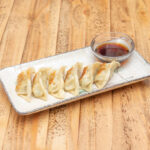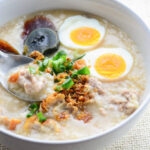Steamed dim sum is a traditional Chinese dish that consists of small, bite-sized portions of various ingredients encased in thin dough wrappers and then steamed to perfection. Hailing from the Cantonese region of China, dim sum is often enjoyed as a brunch or lunch dish and is renowned for its wide variety of flavors and textures. From savory options like dumplings filled with pork, shrimp, or vegetables, to sweet treats like custard-filled buns and glutinous rice cakes, steamed dim sum offers a delightful culinary experience that brings people together to share and savor the diverse tastes of Chinese cuisine. Whether enjoyed at a bustling dim sum restaurant or homemade in the comfort of your kitchen, steamed dim sum is a beloved culinary tradition cherished by food enthusiasts around the world.
| Ingredients | |
| For the dough | |
| 1 | 2 cups all-purpose flour |
| 2 | 1 cup warm water |
| For the filling | |
| 3 | Your choice of filling ingredients such as ground pork, shrimp, vegetables, or a combination |
| 4 | Soy sauce |
| 5 | Sesame oil |
| 6 | Salt and pepper to taste |
| 7 | Optional: minced garlic, minced ginger, chopped green onions, or other seasonings of your choice |
Step-by-step cooking instruction of Steamed Dim Sum:
Step-1 Prepare the dough:
- Combine the warm water and all-purpose flour in a large mixing basin.
- Knead the mixture until it forms smooth dough. If the dough is too sticky, add a little more flour; if it’s too dry, add a little more water.
- Cover the dough with a damp cloth and let it rest for about 30 minutes.
Step-2 Prepare the filling:
- If using ground pork or shrimp, cook them first until they’re fully cooked. You can sauté them with some minced garlic and ginger for extra flavor.
- Chop any vegetables you’re using finely.
- In a mixing bowl, combine the cooked meat or seafood with the chopped vegetables.
- Season the filling mixture with soy sauce, sesame oil, salt, pepper, and any other seasonings you like. Mix well.
Step-3 Assemble the dim sum:
- Partition the dough into tiny, uniform pieces once it has rested.
- Roll each portion into a small ball and then flatten it into a circle with your fingers or a rolling pin. The circle should be thin but not too thin to tear easily.
Step-4 Fill and wrap:
- Place a spoonful of the filling mixture onto the center of each dough circle.
- Fold the edges of the dough circle up and around the filling to create a small parcel or purse, pinching the edges together to seal tightly. For a more ornamental appearance, you can also pleat the edges.
Step-5 Steam the dim sum:
- Arrange the filled dim sum on a steamer lined with parchment paper or cabbage leaves to prevent sticking.
- Bring water to a boil in the steamer, and then reduce the heat to a simmer.
- Place the steamer over the pot of simmering water and steam the dim sum for about 10-15 minutes, or until the dough is cooked through and the filling is heated.
- Serve hot with dipping sauce of your choice, such as soy sauce, chili oil, or a mixture of soy sauce and rice vinegar.
Nutritional values of Steamed Dim Sum:
The nutritional values of steamed dim sum can vary greatly depending on the specific ingredients used in the filling and dough. However, here’s a general overview of the nutritional components you might find in steamed dim sum:
| 1 | Carbohydrates: The dough used to make dim sum wrappers primarily consists of carbohydrates from flour. This provides energy for the body. |
| 2 | Protein: The protein content of steamed dim sum depends on the filling ingredients. Dim sum can be filled with various proteins such as pork, shrimp, chicken, or tofu. These proteins contribute to muscle repair and growth. |
| 3 | Fat: Depending on the filling ingredients, steamed dim sum may contain fats from sources like pork, shrimp, or oils used in cooking. While fats are essential for energy and nutrient absorption, they should be consumed in moderation. |
| 4 | Fiber: If the dim sum includes vegetable fillings, it may contain dietary fiber, which is beneficial for digestive health and can help regulate blood sugar levels. |
| 5 | Vitamins and minerals: Steamed dim sum may contain vitamins and minerals depending on the ingredients used. Vegetables can provide vitamins A, C, and K, as well as minerals like potassium and folate. Meat or seafood fillings may contain iron, zinc, and B vitamins. |
| 6 | Sodium: Soy sauce, a common seasoning in dim sum fillings, is high in sodium. Consuming too much sodium can contribute to high blood pressure and other health issues, so it’s important to consume dim sum in moderation, especially if you have hypertension or other cardiovascular concerns. |
Background History of Steamed Dim Sum
The history of steamed dim sum is deeply rooted in Chinese culinary tradition, particularly originating from the Cantonese region of southern China. The term “dim sum” itself translates to “touch the heart” in Cantonese, reflecting its role not only as a culinary delight but also as a social and cultural experience.
Dim sum is believed to have originated over 2,000 years ago during the time of the Silk Road, where travelers would stop at tea houses along the journey to rest and refresh themselves. Tea houses began serving small, savory snacks to accompany the tea, which evolved into the diverse array of dim sum we know today.
The practice of serving dim sum spread throughout China, becoming especially popular in the bustling city of Hong Kong and the surrounding Guangdong province. Dim sum houses, known as “yum cha” establishments, became social hubs where people gathered to enjoy tea and a wide assortment of bite-sized delicacies.
Steamed dim sum, in particular, became one of the hallmark dishes of Cantonese cuisine. The delicate art of preparing and steaming these small parcels of goodness requires skill and precision, with chefs mastering the technique over years of practice.
Over time, dim sum has transcended its origins and become a beloved culinary tradition enjoyed around the world. From Hong Kong to New York City, dim sum restaurants attract food enthusiasts eager to sample an assortment of dumplings, buns, rolls, and other delectable offerings.
Beyond its culinary appeal, dim sum also holds cultural significance, symbolizing togetherness, hospitality, and the joy of sharing a meal with loved ones. Whether enjoyed as a leisurely weekend brunch or a quick snack on the go, steamed dim sum continues to captivate hearts and palates, carrying with it centuries of tradition and flavor.
| Advantages of Steamed Dim Sum | |
| 1 | Healthy Cooking Method: Steaming is considered one of the healthiest cooking methods as it doesn’t require additional fats or oils, making steamed dim sum lower in calories and fat compared to fried alternatives. |
| 2 | Retains Nutrients: Steaming preserves the nutrients in the ingredients better than other cooking methods like frying or boiling, ensuring that the dim sum retains its nutritional value. |
| 3 | Delicate Texture: Steaming results in a delicate and moist texture for the dough and filling, allowing the flavors of the ingredients to shine through without being masked by excess oil or grease. |
| 4 | Versatile Fillings: Steamed dim sum can be filled with a wide variety of ingredients, including lean proteins, vegetables, and seafood, providing versatility in flavor and texture options. |
| 5 | Easy Digestion: Steamed dim sum is typically easier to digest compared to fried foods, making it a suitable option for individuals with sensitive stomachs or digestive issues. |
| Disadvantages of Steamed Dim Sum | |
| 1 | Labor Intensive: Making steamed dim sum from scratch can be time-consuming and labor-intensive, especially the preparation of the dough and filling, as well as the wrapping process. |
| 2 | Skill Required: Achieving the perfect texture and flavor of steamed dim sum requires skill and practice, particularly in shaping and sealing the dough parcels to prevent leakage during steaming. |
| 3 | Limited Texture Variety: Steaming produces a soft and tender texture, which may not appeal to those who prefer crispy or crunchy textures typically associated with fried foods. |
| 4 | Equipment Needed: Steaming dim sum requires specialized equipment such as a steamer, which may not be readily available in every kitchen and can take up extra storage space. |
| 5 | Potential for Overcooking: Steamed dim sum can easily become overcooked if left in the steamer for too long, resulting in a mushy texture and loss of flavor. |
Compare with Similar meal of Steamed Dim Sum:
Similar meals to steamed dim sum include various types of dumplings and Asian-inspired appetizers that are steamed, boiled, or pan-fried. Here are some examples:
| 1 | Pan-Fried Dumplings (Potstickers): These are similar to steamed dumplings but are pan-fried until crispy on the bottom while remaining tender on the top. They’re typically filled with a mixture of ground meat (such as pork or chicken), vegetables, and seasonings. |
| 2 | Boiled Dumplings: Also known as boiled jiaozi in Chinese cuisine, these dumplings are filled with a variety of ingredients, similar to steamed dim sum. They are boiled in water until they float to the surface, then served with dipping sauce. |
| 3 | Baozi (Steamed Buns): These are soft, fluffy buns filled with savory or sweet fillings. Common savory fillings include BBQ pork, chicken, or vegetables, while sweet fillings can include red bean paste or custard. |
| 4 | Shumai: These are open-topped dumplings typically filled with a mixture of ground pork, shrimp, and sometimes mushrooms or water chestnuts. Steamed, they are frequently served with a dipping sauce. |
| 5 | Har Gow (Shrimp Dumplings): These are translucent dumplings filled with shrimp and sometimes bamboo shoots or water chestnuts. They are wrapped in a delicate, translucent wrapper made from wheat starch and tapioca flour, then steamed. |
| 6 | Spring Rolls: These are thin wrappers filled with a variety of ingredients such as shredded vegetables, vermicelli noodles, and sometimes meat or shrimp. They can be deep-fried or, for a healthier option, steamed or pan-fried. |
| 7 | Wontons: These are similar to dumplings but typically have a thinner wrapper and are often filled with a mixture of ground meat and seasonings. They can be served in a clear broth or steamed and served with dipping sauce. |
| 8 | Rice Noodle Rolls (Cheong Fun): These are wide rice noodles filled with ingredients such as shrimp, BBQ pork, or vegetables, then rolled up and steamed. They are often served with a savory soy sauce or hoisin sauce. |
Mostly questions asked about Steamed Dim Sum
1: What is steamed dim sum?
A: Steamed dim sum is a traditional Chinese dish consisting of small, bite-sized portions of various ingredients encased in thin dough wrappers and then steamed to perfection.
2: What are the most popular types of steamed dim sum?
A: Some of the most popular types of steamed dim sum include dumplings (such as har gow and shumai), steamed buns (baozi), rice noodle rolls (cheong fun), and shrimp dumplings (har gow).
3: How do you eat steamed dim sum?
A: Steamed dim sum is typically served family-style, with multiple dishes brought to the table for sharing. Diners use chopsticks or small serving utensils to select the dim sum they’d like to try and enjoy them with dipping sauces like soy sauce, chili oil, or hoisin sauce.
4: What are the health benefits of steamed dim sum?
A: Steamed dim sum is generally considered healthier than fried alternatives, as it is cooked without additional fats or oils. It retains more nutrients and has fewer calories and less saturated fat compared to fried dim sum options.
5: Can I make steamed dim sum at home?
A: Yes, steamed dim sum can be made at home with some practice and basic cooking equipment. There are many recipes available online, and homemade dim sum can be customized with your favorite fillings and flavors.
6: What are some common fillings for steamed dim sum?
A: Common fillings for steamed dim sum include ground pork, shrimp, chicken, vegetables (such as cabbage, mushrooms, or water chestnuts), and combinations of these ingredients. Seasonings like soy sauce, sesame oil, and ginger are often used to enhance the flavor.
7: Can steamed dim sum be made ahead of time?
A: Yes, steamed dim sum can be made ahead of time and reheated before serving. Simply store the cooked dim sum in an airtight container in the refrigerator and steam them again until heated through before serving.
8: Are there vegetarian or vegan options for steamed dim sum?
A: Yes, there are many vegetarian and vegan options for steamed dim sum. Fillings can include tofu, mushrooms, vegetables, and other plant-based ingredients, seasoned with vegetarian-friendly sauces and spices.
9: What is the proper way to steam dim sum?
A: To steam dim sum, place them on a parchment-lined steamer basket or bamboo steamer over boiling water. Cover and steam until the dough is cooked through and the filling is heated, usually around 10-15 minutes depending on the size of the dim sum.
10: Where can I find authentic steamed dim sum?
A: Authentic steamed dim sum can be found at Chinese dim sum restaurants, particularly those specializing in Cantonese cuisine. Many larger cities have dim sum restaurants or Chinese bakeries that offer a variety of steamed dim sum options.







